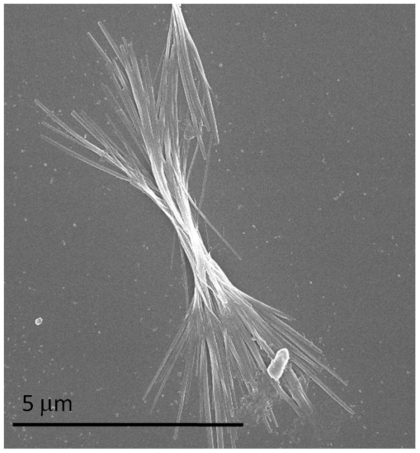Light can induce twisting in semiconductor nanoribbons
Self-organization of nanoparticles (NPs) can create advanced architectures such as nanowires (NWs), nanosheets (NSes), nanotubes, and nanoplates. They have many possible applications in electronic-device development, biomedicine, and other areas. Different mechanisms and routes have been reported that use noncovalent interactions between NPs to create these morphologies. An interesting topic to investigate regarding their assembly is the way that changes in physical conditions, such as ambient light, can affect their overall structural shape.
We have investigated self-assembly of cadmium telluride (CdTe) NPs under controlled conditions of visible-light irradiation, producing helically twisted nanoribbons (TRs)1 with pitch lengths ranging from 1500 to 250nm under varying degrees of illumination. In contrast, we did not observe any twisting when the ribbons were assembled in complete darkness. Although light is known to affect matter, the use of ambient-light illumination to twist or bend wires by a few nanometers has not been reported before.
The dipolar interactions involved in the self-assembly of CdTe NPs can create 1D NWs2 and 2D NSs.3 Using the same concept, we prepared an aqueous solution of CdTe NPs with thioglycolic acid (TGA) as a capping agent. We used a Cd2+/TGA ratio close to unity instead of the typical value of 2.4 used for 1D NW formation. The lower amount of TGA is expected to reduce the local concentration on the tetrahedral corners of NPs and increase the dipole of the particles.
We first precipitated CdTe NPs in methanol and centrifuged them. They were then redispersed in water at pH 9 (pH: Measure of acidity or basicity of a solution). The orange color of the initial NP solution turned to dark green in three days in the presence of ambient light. We analyzed the samples under scanning-electron microscopy (SEM) and transmission-electron microscopy (TEM) and found that TRs had formed.1 The TRs were 1 to 2μm in length, with a helical pitch length of ~400nm (see Figure 1). We examined the direction of helicity for some 100 TRs and observed a racemic distribution of left- and right-handed ribbons. Under high-resolution TEM (HRTEM), the TRs showed a polycrystalline structure composed of both CdTe and cadmium sulfide (CdS) NPs. Because less TGA was used in the fabrication of the CdTe NPs, the particles were more exposed to Te oxidation. In this process, Te2− is oxidized and the excess of Cd2+ present in the particles reacts with the remaining S2− resulting from TGA decomposition to form CdS. This explains the composition of the resulting TRs.
Interestingly, the same procedure, when carried out in complete darkness, showed the same polycrystalline structure composed of CdTe/CdS NPs, but with no twisting (straight ribbons): see Figure 2. Because both CdTe and CdS are sensitive to light, the twisting is believed to be related to the exposure to ambient light.
To further investigate the effect of light illumination on the assembly of CdTe NPs into TRs, we exposed the solution described above to various levels of light illumination. The resulting TRs showed a sequential alteration in pitch length from 250 to 1500nm with increasing illumination. HRTEM observations showed that all TRs exhibited the same polycrystalline structure composed of CdTe/CdS NPs. The results clearly indicate the importance of ambient light. The wires prepared in the dark were also wider than the TRs prepared under ambient light.
The intermediate stages of sample preparation also supported the suggestion that photo-oxidation caused the twisted structures. We found unusual shapes (such as ellipsoids, dumbbell shapes, and bunches of ribbons) as intermediate stages and TRs finally emerged from these multiparticle assemblies. To further confirm that the pitch length of the TRs is controlled by ambient light, we also examined the duration of the illumination rather than its intensity. The CdTe samples were initially kept in complete darkness to form straight ribbons and then introduced to irradiation with ambient light for one day. The results showed a sequential change in pitch length from straight to ~600 and 400nm after 12 and 24hr, respectively, under ambient light. Theoretical calculations and simulations revealed that the resulting geometry and dimensionality are also controlled by electrostatic attraction and repulsion in the NP assemblies.
TRs with variable pitch length provide a new shape for use in nanotechnology. Nanoscale twisted propellers inspired by nature mimic the alpha-helical structures found in biomolecules such as proteins and DNA. Helical TRs similar to biomolecules could thus be used to control drug delivery as well as in microfluidic systems used in experiments to simulate the body. This newly discovered twisting effect could also be applied to create variable micro-electromechanical systems that are controlled by visible light. Similarly, the TRs could be used in lithography technologies and in designing microchips. Semiconductor materials can be applied as superchiral structures, which may have smart applications in the field of negative-refractive-index materials. We are currently investigating methods to construct chiral structures twisted in one direction for application as metamaterials. To further use this morphology for metamaterials with negative refractive index, we are also investigating new procedures to use them as templates for creating metallic wires with a similar twisted morphology.
Sudhanshu Srivastava works as a research fellow with Nicholas Kotov. His research focuses on the spontaneous assembly of nanoparticles for construction of nanowires, nanoribbons, and other advanced architectures. He is also investigating exponential layer-by-layer assembly for loading and unloading of nanomaterials.
Nicholas Kotov is a professor. His research interests include nanocolloids, their assembled structures, layer-by-layer assembly, ultrastrong materials from carbon nanotubes and clays, nanomaterials for energy storage, interfacing neural tissues with nanomaterials, and diagnostics with nanoparticles.


